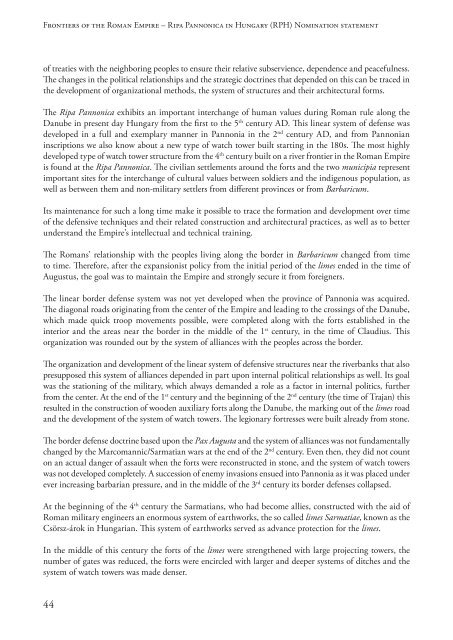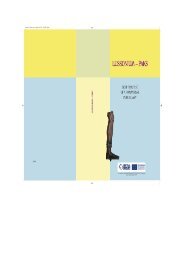the PDF version! - Danube Limes
the PDF version! - Danube Limes
the PDF version! - Danube Limes
You also want an ePaper? Increase the reach of your titles
YUMPU automatically turns print PDFs into web optimized ePapers that Google loves.
Frontiers of <strong>the</strong> Roman Empire – Ripa Pannonica in Hungary (RPH) Nomination statement<br />
of treaties with <strong>the</strong> neighboring peoples to ensure <strong>the</strong>ir relative subservience, dependence and peacefulness.<br />
The changes in <strong>the</strong> political relationships and <strong>the</strong> strategic doctrines that depended on this can be traced in<br />
<strong>the</strong> development of organizational methods, <strong>the</strong> system of structures and <strong>the</strong>ir architectural forms.<br />
The Ripa Pannonica exhibits an important interchange of human values during Roman rule along <strong>the</strong><br />
<strong>Danube</strong> in present day Hungary from <strong>the</strong> first to <strong>the</strong> 5 th century AD. This linear system of defense was<br />
developed in a full and exemplary manner in Pannonia in <strong>the</strong> 2 nd century AD, and from Pannonian<br />
inscriptions we also know about a new type of watch tower built starting in <strong>the</strong> 180s. The most highly<br />
developed type of watch tower structure from <strong>the</strong> 4 th century built on a river frontier in <strong>the</strong> Roman Empire<br />
is found at <strong>the</strong> Ripa Pannonica. The civilian settlements around <strong>the</strong> forts and <strong>the</strong> two municipia represent<br />
important sites for <strong>the</strong> interchange of cultural values between soldiers and <strong>the</strong> indigenous population, as<br />
well as between <strong>the</strong>m and non-military settlers from different provinces or from Barbaricum.<br />
Its maintenance for such a long time make it possible to trace <strong>the</strong> formation and development over time<br />
of <strong>the</strong> defensive techniques and <strong>the</strong>ir related construction and architectural practices, as well as to better<br />
understand <strong>the</strong> Empire’s intellectual and technical training.<br />
The Romans’ relationship with <strong>the</strong> peoples living along <strong>the</strong> border in Barbaricum changed from time<br />
to time. Therefore, after <strong>the</strong> expansionist policy from <strong>the</strong> initial period of <strong>the</strong> limes ended in <strong>the</strong> time of<br />
Augustus, <strong>the</strong> goal was to maintain <strong>the</strong> Empire and strongly secure it from foreigners.<br />
The linear border defense system was not yet developed when <strong>the</strong> province of Pannonia was acquired.<br />
The diagonal roads originating from <strong>the</strong> center of <strong>the</strong> Empire and leading to <strong>the</strong> crossings of <strong>the</strong> <strong>Danube</strong>,<br />
which made quick troop movements possible, were completed along with <strong>the</strong> forts established in <strong>the</strong><br />
interior and <strong>the</strong> areas near <strong>the</strong> border in <strong>the</strong> middle of <strong>the</strong> 1 st century, in <strong>the</strong> time of Claudius. This<br />
organization was rounded out by <strong>the</strong> system of alliances with <strong>the</strong> peoples across <strong>the</strong> border.<br />
The organization and development of <strong>the</strong> linear system of defensive structures near <strong>the</strong> riverbanks that also<br />
presupposed this system of alliances depended in part upon internal political relationships as well. Its goal<br />
was <strong>the</strong> stationing of <strong>the</strong> military, which always demanded a role as a factor in internal politics, fur<strong>the</strong>r<br />
from <strong>the</strong> center. At <strong>the</strong> end of <strong>the</strong> 1 st century and <strong>the</strong> beginning of <strong>the</strong> 2 nd century (<strong>the</strong> time of Trajan) this<br />
resulted in <strong>the</strong> construction of wooden auxiliary forts along <strong>the</strong> <strong>Danube</strong>, <strong>the</strong> marking out of <strong>the</strong> limes road<br />
and <strong>the</strong> development of <strong>the</strong> system of watch towers. The legionary fortresses were built already from stone.<br />
The border defense doctrine based upon <strong>the</strong> Pax Augusta and <strong>the</strong> system of alliances was not fundamentally<br />
changed by <strong>the</strong> Marcomannic/Sarmatian wars at <strong>the</strong> end of <strong>the</strong> 2 nd century. Even <strong>the</strong>n, <strong>the</strong>y did not count<br />
on an actual danger of assault when <strong>the</strong> forts were reconstructed in stone, and <strong>the</strong> system of watch towers<br />
was not developed completely. A succession of enemy invasions ensued into Pannonia as it was placed under<br />
ever increasing barbarian pressure, and in <strong>the</strong> middle of <strong>the</strong> 3 rd century its border defenses collapsed.<br />
At <strong>the</strong> beginning of <strong>the</strong> 4 th century <strong>the</strong> Sarmatians, who had become allies, constructed with <strong>the</strong> aid of<br />
Roman military engineers an enormous system of earthworks, <strong>the</strong> so called limes Sarmatiae, known as <strong>the</strong><br />
Csörsz-árok in Hungarian. This system of earthworks served as advance protection for <strong>the</strong> limes.<br />
In <strong>the</strong> middle of this century <strong>the</strong> forts of <strong>the</strong> limes were streng<strong>the</strong>ned with large projecting towers, <strong>the</strong><br />
number of gates was reduced, <strong>the</strong> forts were encircled with larger and deeper systems of ditches and <strong>the</strong><br />
system of watch towers was made denser.<br />
44











